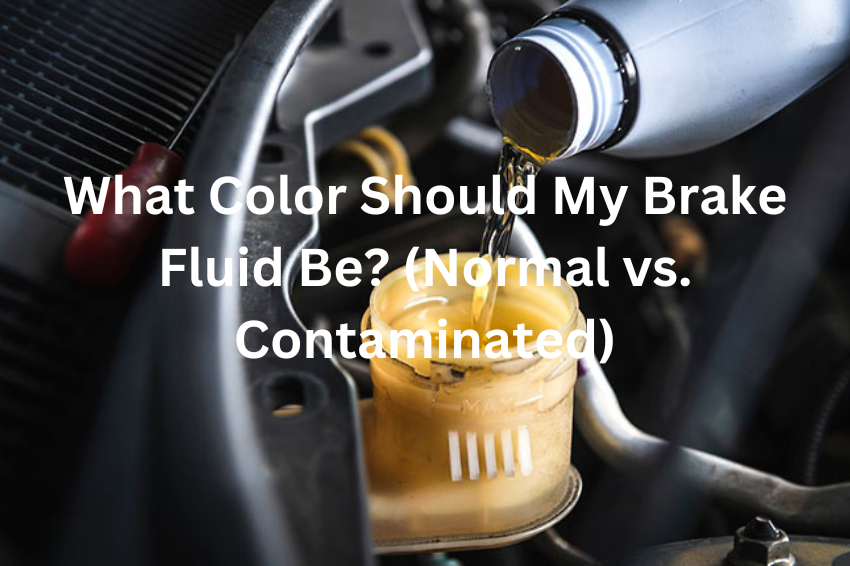As a certified automotive technician, I understand the importance of a properly functioning brake system.
One way to ensure optimal braking performance is to monitor the condition of your brake fluid.
This guide will prepare you with the knowledge to identify normal vs. contaminated brake fluid based on color and provide valuable information on preventive maintenance to keep your brakes safe and reliable.
Let’s get to It.
What Color Is Normal Brake Fluid And What Does Dark Fluid Mean?
Maintaining healthy brake fluid is essential for safe and reliable stopping power.
But how can you tell if your brake fluid is in good shape?
One easy way is by checking its color.
Just like any new fluid, fresh brake fluid has a clean and inviting appearance.
Typically, it will be clear, light yellow, or amber.
This bright coloring signifies that the fluid is free of contaminants and performing its job effectively.
If you take a peek at your brake fluid reservoir and find a color resembling dark brown or even black, it’s a strong signal that something’s not right.
This appearance indicates that your brake fluid has become contaminated.
However, the primary reason behind brake fluid discoloration is moisture.
Brake fluid, by its nature, is hygroscopic, meaning it attracts moisture from the surrounding air.
Over time, this absorbed water can degrade the fluid’s performance and lead to a darker color.
Why Dark Brake Fluid Matters
Contaminated brake fluid poses a significant threat to your braking system.
Here’s why:
- Reduced Boiling Point
Brake fluid has a specific boiling point, the temperature at which it turns into vapor.
Moisture lowers this boiling point.
Imagine a scenario where you’re forced to brake hard on a steep downhill road.
The increased pressure and heat can cause contaminated fluid to boil.
Those vapor bubbles are compressible, unlike fluid, which can lead to a scary situation, a spongy brake pedal, and a significant decrease in braking power, often referred to as brake fade.
Brake fade is a condition where the brakes become less effective due to excessive heat.
With contaminated fluid, this can happen much easier.
Imagine pressing the brake pedal down firmly, but the car doesn’t slow down as expected. This lack of responsiveness can be extremely dangerous in emergencies.
- Corrosion Concerns:
Contaminated brake fluid can also contribute to corrosion within the brake system components like calipers, wheel cylinders, and brake lines.
This rust and corrosion can damage these important parts, leading to expensive repairs and potentially even complete brake failure.
If you discover dark or dirty brake fluid, don’t panic.
This is a common issue that can be addressed.
Expert Tip: I recommend consulting your car’s owner’s manual for the manufacturer’s recommended service interval for brake fluid changes. This will differ depending on your vehicle’s make, model, and driving habits.
How Often Should I Change My Brake Fluid?
The best way to determine how often you should change your brake fluid is to consult your car’s owner’s manual.
Every manufacturer has specific recommendations based on the vehicle’s design and braking system.
In general, most manufacturers recommend changing your brake fluid every 2-3 years or 40,000-60,000 miles, whichever comes first.
Remember how we talked about brake fluid attracting moisture from the air?
Over time, this absorbed moisture can lower the boiling point of the fluid.
This is why manufacturers recommend changing the fluid periodically to prevent moisture buildup and ensure the fluid performs as intended.
However, these intervals are a general guideline.
Your actual driving habits can influence how quickly moisture accumulates in the brake fluid.
Here’s what to consider:
- Severe Driving Conditions: If you frequently experience stop-and-go traffic, mountain driving with steep descents, or tow heavy loads, your brakes work harder and generate more heat. This heat can accelerate moisture absorption in the brake fluid. In such cases, consulting a mechanic about more frequent changes might be a good idea.
- Mostly Highway Driving: Also, if you primarily drive on highways with minimal braking, the moisture buildup might be slower. Following the manufacturer’s recommended interval might be perfectly adequate.
While this provides a helpful overview, it’s important to remember that every car is different.
For the most accurate information on your specific vehicle, consult your owner’s manual or refer to a qualified mechanic.
They can assess your driving habits and recommend the most suitable brake fluid change schedule for your car.
Even if you haven’t reached the recommended mileage or time interval, there are situations where your brake fluid might need earlier attention.
Here are some warning signs:
- Dark or Dirty Brake Fluid: As discussed earlier, a dark brown or black color indicates contamination and potential moisture buildup.
- Spongy Brake Pedal: If your brake pedal feels soft or mushy when pressed, it could be a sign of air or moisture in the brake system, necessitating a fluid flush.
- Increased Stopping Distance: If you notice it takes longer than usual for your car to come to a complete stop, it might be a sign of compromised brake fluid performance.
If you experience any of these signs, don’t hesitate to schedule an appointment with a mechanic for a brake system inspection and potential fluid flush.
Reference Sources:
